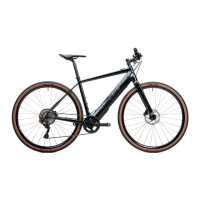GENERAL MAINTENANCE AND
PERIODICAL CHECKS
Take care of your bicycle, and you will enjoy it for a longer time. Also take some time to
periodically inspect the bicycle in more detail - this is important for your safety. Here is
some basic information.
CARING FOR ALUMINIUM FRAMES
Aluminium frames are prone to corrosion if not taken care of properly. Regular cleaning
will remove salt and other chemicals from the surface of your bicycle minimising the
likelihood of external corrosion. It is very important that paint chips and scratches
get touched up as soon as possible with factory touch-up paint or nail polish. Prior to
painting, make sure that the surface is free of corrosion, clean and dry. The frame does
not require any lubrication.
PERIODICAL CHECKS
A brief inspection of the frame, fork and bars for any signs of damage should be done
prior to every ride. If you suspect it may be broken, bent, cracked, do not use it. Inspect
if the steer tube and fork blades are straight and dropouts for cracks or damage. Do not
ride on the damaged fork - it may cause serious injury or death.
A good time to give your bike a thorough check for cracks or other defects is when
you are washing it since the problems will become easier to see. When inspecting your
bicycle make sure the lighting is good (e.g. outdoors). Check the bike on its wheels, and
then turn it upside-down and check it again.
WARNING: The handlebars should be replaced at every two years as they are submitted
to fatigue.
Check the cranks for play (hold the bike with one hand, and the pedals with the other
and look for play by trying to push the pedals from one side of the bike to the other). If
any play is found, contact your local bike shop. Periodically check hubs for play and have
the bearings adjusted if necessary, by a professional bicycle mechanic. The bearings
should be lubricated about once a year. Keep your chain cleaned and lubricated. This
is especially important if you ride often in wet conditions. Use proper bicycle chain
lubricants.
WARNING: As for all mechanical components, the bicycle is subject to wear and tear as
well as high stresses. Nothing lasts forever! The reaction of various materials and compo-
nents to wear or stress fatigue may dier. Having exceeded the life expectancy of a com-
ponent may result in its sudden failure, possibly causing injuries to the rider. Any forms
of breaks, cracks, scratches or changes of colouring in highly stressed areas indicate that

